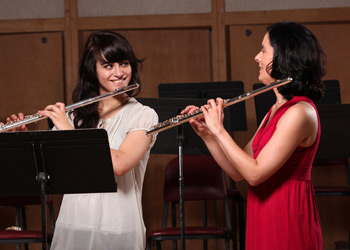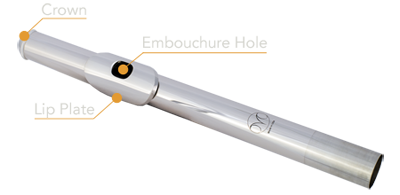Flute Essentials
 |
How to Shop for a Flute
No matter what kind of a player you are, stepping up to a more professional flute is an important decision. There are many features that affect the sound, response and the feel of a flute. Here are some points to help you understand the different elements and to find the best choice for the advancing player.
Play the flute. You want it to feel comfortable and easy to get a good sound on. Be sure to try several flutes to give yourself some perspective. You should be able to produce a strong, centered tone and have good control of the dynamics. You don’t want to have the feeling of working too hard to get your sound. Playing well in the low register and the high register is something that you should take particular note of. The action should be smooth and even and the flute should feel comfortable in your hands. |
Materials
Flutes can be made of Nickel, Silver, Gold or Platinum. Most step-up flutes are made of Nickel Silver (an alloy comprised of copper, zinc and nickel) or Sterling Silver Tubing. Professional flutes are generally made out of Sterling Silver, Gold, and Platinum and even have the key work made from precious metals. You will find that upgrading to a Sterling Silver Headjoint makes a big difference. When you upgrade to the Sterling Silver Body Tubing as well you will notice even more change in color.
 |
The Headjoint
The Flute Headjoint or Mouthpiece is where the sound starts and it is one of the most important components of the flute. It is essential to creating a vibrant, colorful tone. Many student and intermediate level flutes are factory made with very little "hand" work. Professional flutes offer Hand-cut Headjoints which have been carefully fine-tuned to bring out all the wonderful qualities of your flute's sound.
The art of hand cutting a flute head joint requires skill and patience, taking many years to develop. A good Headjoint is designed and crafted to be both responsive and flexible. It offers superb projection and control, making it easier to play high notes and perform at softer volumes. It is that balance that allows the player to be expressive. |
Lip Plate
The Lip Plate is the part of the Headjoint that you rest your lip on. The shape of how you fit against the lip plate and how the air hits the far side of it when you play will both affect the sound and response. How these angles work together should create a good center that is easy to find and which gives you projection and control. Lip plates are also made from precious metals. This changes the tone colors slightly.
Riser
The Riser connects the lip plate to the Headjoint tube. Sometimes they are made from 14K Gold or Platinum. The Shape of the Embouchure Hole and all the little curves and angles in this part really help shape the sound.
Crown & Cork Assembly
The Crown is the cap on top of the Headjoint, which is screwed onto the cork assembly. The crown affects the position of the cork assembly, and the resonance of the flute. Even the Crown and the Cork Assembly weights have subtle effects on the response of a flute.
|
|
|
All North Bridge flutes feature a sterling silver head joint that is handmade in the USA, by flute artisan Chris McKenna. For over 30 years, Chris McKenna has been crafting some of the finest flute head joints available. The art of hand cutting a flute head joint requires tremendous skill, taking many years to develop. The McKenna head joint is designed and crafted to be both responsive and flexible offering superb projection and control, making it easier to hit high notes and perform at softer volumes. The North Bridge flute pairs a McKenna head joint with a perfectly matched and beautifully constructed flute body that is assembled in Taiwan. The result is one of the best sounding and responsive step-up flutes on the market today. |
Pitch
Pitch is the frequency at which your instrument plays. Most flutes are designed to play at A=442, which allows one to play in tune across the range of A=440 to A=444.
Wall Thickness
The thickness of the tubing of the flute is called the wall thickness. This can range from a light wall of .014" to a heavy wall of .018". A lighter wall usually produces a brighter sound while a heavier wall usually produces a darker sound. The North Bridge flutes have a medium wall of .016."

The G Key
The G keys are offered in two configurations, which do not affect the sound of the flute.
On an offset flute, the G keys are on a separate rod, and are offset from the rest of the keys. This makes them a bit easier to reach. Offset flutes seem to be more popular than inline flutes.
On an inline flute, the G keys line up evenly and are on the same rod as the other keys on the flute. In this configuration, the inline G key can be a bit hard to reach for some flutists.
Split E
The high E can be a difficult not for flutists. It tends to be a bit sharp. The Split E mechanism offers greater control and provides better intonation when playing the high E. It works by closing the lower G key, which flattens the E and makes it easier to sound. This is more commonly available in offset G configurations.
|
Open and Closed Hole Keys
Student flutes generally have closed hole keys as they allow the student to play without having to worry about covering the holes completely with their fingers. Open hole keys require the flutist to cover the holes completely in order to make a good sound. They further allow for more options in note bending and pitch control.
C# Trill
The C# trill is usually only found on professional flutes. It is an extra key on the Bb lever, which can be used in alternate fingerings and various trills.
Pointed Arms VS. Y Arms
The arms connect the key cups to the flute mechanism. Y-arms hold the key cup from the back edge. Pointed arms hold the key cup from the center. Pointed arms are found on professional flutes, cosmetically beautiful, and tend to stay in better adjustment than Y arms.
Pivot Screws and Adjustment Screws
Pivot screws act as a bearing point on the mechanism. They can be either pointed or cylindrical. Pointed pivot screws provide a precise fitting, but can create movement in the key when they go out of adjustment. Cylindrical pivot screws are less precise but easier to work with and more stable. They do not cause movement when they go out of adjustment.
Adjustment screws control the height and regulation of many keys on the flute. They can be found on top of, or below, the keys themselves. |
North Bridge flutes feature a wall thickness of .016" and pitch of A=442. They come in both Y arms (NB-600) and pointed arms (NB-500 and NB-700). North Bridge flutes and are currently only offered with open holes, in offset G configurations, with a Split E option. Both C and B foots are available.
|
|
|
Mechanism
The mechanism is the entire key section of the flute.
Tone Holes
The tone hole is the opening in the flute body that is covered by a pad, contained in a key cup. Most flutes are made with drawn tone holes, as it is an efficient manufacturing technique.
When making a drawn tone hole, a small hole is punched in the tube. The wall of the tone hole is then drawn up from the body. It is milled flat, and the edge is rolled over to form a smooth surface for the key. Drawn Tone Holes are “drawn” or extruded from the flute tube itself so there is no solder seam like on soldered tone hole flutes.
If a tone hole is soldered, a separate piece of metal is machined to make the tone hole. This is then soldered to the body tube. This method allows greater wall thicknesses, and a more level surface. This technique requires much more hand crafting and is usually only found on high end professional flutes. |
D# Roller
The D# roller is cut into the D# lever to make it easy to slide from the D# to the C#.
Gizmo
The gizmo is an extra lever attached to the low B key on the footjoint. It closes the low B key to make it easier to play the 3rd octave C. |
|
| |
North Bridge Features |
NB-500 |
NB-600 |
NB-700 |
|
|
| |
Sterling Silver handmade headjoint by Chris McKenna |
X |
X |
X |
|
| |
Headjoint country of origin |
USA |
USA |
USA |
|
| |
Flute Body Tube country of origin |
Japan |
Taiwan |
Taiwan |
|
| |
Sterling Silver body/footjoint |
|
x |
x |
|
| |
Arms |
Pointed |
Y-arms |
Pointed |
|
| |
Silver plated keys |
X |
X |
X |
|
| |
.016" Medium tubing |
X |
X |
X |
|
| |
Quality Pisoni pads |
X |
X |
X |
|
| |
A-442 Pitch |
X |
X |
X |
|
| |
Offset G with Split E available |
X |
X |
X |
|
| |
French-style case and nylon case cover |
X |
X |
X |
|
| |
Tested and Adjusted |
USA |
USA |
USA |
|
| |
Assembled in: |
Taiwan |
Taiwan |
Taiwan |
|
|
|
